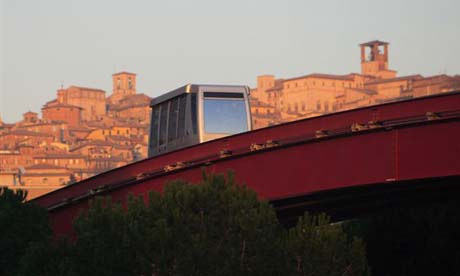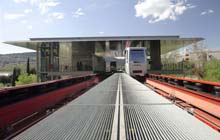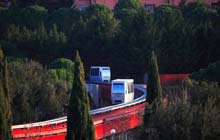The arrival of Perugia's new 'Mini Metro' is providing a car-free way to visit this ancient city, but it still has to win over its critics. Bernhard Warner reports

Train to the future ... Perugia’s Mini Metro rail line climbs for 3km from the valley floor to the historic centre in just 11 minutes
Perugia, the hilltop capital city of Umbria, was built to repel invaders. Today, this would mean motorists, or anybody trying to navigate its precariously narrow roads to reach the splendid 14th-century Palazzo dei Priori that sits at its highest point and the nearby people-watching hot spot of Corso Vannucci.
Like hill towns across Europe, this Etruscan stronghold, surrounded by a massive travertine wall, was simply not designed to accommodate visitors en masse - on foot or in coaches. As for hosting jazz festivals or chocolate festivals, for which Perugia is famous, the strain on the city's foundation shows. Parking spots are precious and the unsightly queue of idling coaches crammed beneath a 2,300-year-old Etruscan arch or beside a medieval aqueduct is hardly a welcoming sight.
 But starting this summer, the city may have found a solution with a €95 million light rail project, Perugia's most ambitious and controversial public works initiative since the early 1980s when the city burrowed through the Rocca Paolina, a medieval citadel, to create a new entrance into the historic centre.
But starting this summer, the city may have found a solution with a €95 million light rail project, Perugia's most ambitious and controversial public works initiative since the early 1980s when the city burrowed through the Rocca Paolina, a medieval citadel, to create a new entrance into the historic centre.
Dubbed the "Mini Metro", the rail line, which starts from the valley floor, climbs for 3km, wiggles around ancient constructions and monuments, and drops visitors off in the historic centre where an unobstructed view of Assisi and the rolling countryside gleams in the distance. Total travel time? 11 minutes.
At first look, the sight of pilot-less metallic pods shuttling people up and down the hillside on an elevated track seems, to put it mildly, anachronistic. Call it Tron-meets-Dante in the Umbrian hills.
Debuting earlier this year, the Mini Metro has already created a fuss. Transport specialists from Vienna and Spain's Santiago de Compostela have visited Perugia to inquire about bringing a similar model to their cities. Many locals though have given it a cold welcome, complaining about the continuous hum of the cable pulleys.
 Built by Leitner Technologies, an Italian engineering firm better known for its ski gondolas and high-speed lifts, the mini metro is being hailed as an engineering first. It promises to greatly improve access to this ancient fortified city without trampling on the city's past, and in an environmentally friendly fashion. The Mini Metro has the capacity to bring 3,000 visitors into the city per hour and 72,000 in and out every day, going a long way towards eliminating exhaust-belching coaches.
Built by Leitner Technologies, an Italian engineering firm better known for its ski gondolas and high-speed lifts, the mini metro is being hailed as an engineering first. It promises to greatly improve access to this ancient fortified city without trampling on the city's past, and in an environmentally friendly fashion. The Mini Metro has the capacity to bring 3,000 visitors into the city per hour and 72,000 in and out every day, going a long way towards eliminating exhaust-belching coaches.